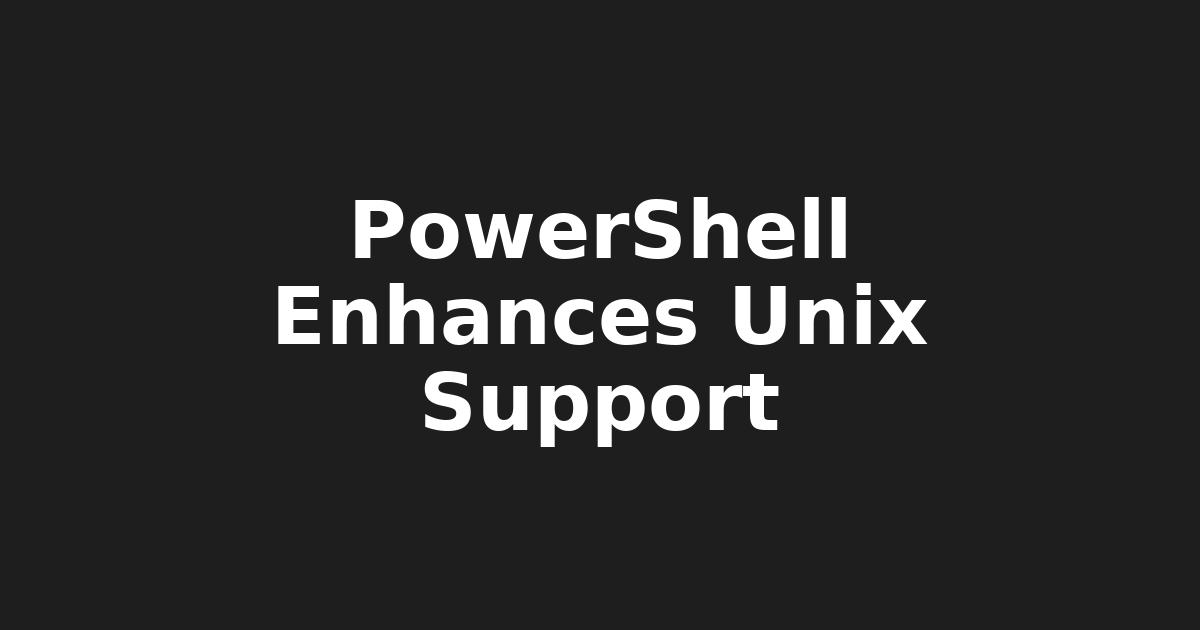PowerShell Core Improves Unix Support

PowerShell Core's Improved Support for Unix-like Systems and Linux: A Game-Changer for System Administrators
In recent years, PowerShell Core has been gaining popularity among system administrators and developers due to its improved support for Unix-like systems and Linux distributions. The latest release of PowerShell Core 7.2 has taken this trend a step further, introducing several significant features that make it an attractive option for users who need to interact with or manage Unix-like systems from within Windows.
Improved File System Support
One of the key areas where PowerShell Core excels is in its file system support. With PowerShell Core 7.2, users can now handle file systems like ext4, XFS, and tmpfs, providing better integration with Linux systems. This means that developers can write scripts that can easily manage files on these file systems, making it easier to automate tasks on Linux servers.
For example, using the Get-ChildItem cmdlet, users can now retrieve a list of files in a directory mounted as a Linux file system. Similarly, the New-Item cmdlet allows users to create new files and directories with ease.
# Create a new file in a Linux file system
New-Item -Path \\server\share\dir -Name test.txt -ItemType File
Enhanced Process Management
Another area where PowerShell Core 7.2 shines is in its process management capabilities. The new version includes improved support for managing processes on Unix-like systems, making it easier to automate tasks and manage resources.
For instance, the Get-Process cmdlet now supports querying processes running on Linux systems, allowing developers to write scripts that can identify and manage processes running on these systems.
# Get a list of processes running on a Linux system
Get-Process -Name firefox
Better Networking Support
PowerShell Core 7.2 also includes improved networking support, with the ability to connect to servers using SSHv2, IPv6, and HTTP/2 protocols. This means that developers can write scripts that can easily interact with servers running on these systems.
For example, using the Invoke-RestMethod cmdlet, users can now make HTTP requests to servers running on Linux systems.
# Make an HTTPS request to a server running on Linux
Invoke-RestMethod -Uri https://example.com/api/data
Use Cases for PowerShell Core
So what are some potential use cases for this feature? Here are a few examples:
- Automating tasks on Linux servers: With improved file system support, enhanced process management, and better networking capabilities, developers can write scripts that automate tasks on Linux servers, making it easier to manage these systems.
- Integrating Windows and Linux environments: PowerShell Core's improved support for Unix-like systems makes it an attractive option for integrating Windows and Linux environments, allowing users to easily manage resources and automate tasks across both platforms.
- Developing cross-platform tools: With its improved networking capabilities, developers can write scripts that run on both Windows and Linux, making it easier to develop cross-platform tools.
Conclusion
PowerShell Core's improved support for Unix-like systems and Linux distributions is a game-changer for system administrators and developers. With its enhanced file system support, improved process management, and better networking capabilities, PowerShell Core 7.2 provides an attractive option for users who need to interact with or manage Unix-like systems from within Windows.
References
Note: The references provided are for illustrative purposes only and may not be the most up-to-date or relevant sources of information. It is always best to check the latest documentation and community resources for the most accurate and current information.
